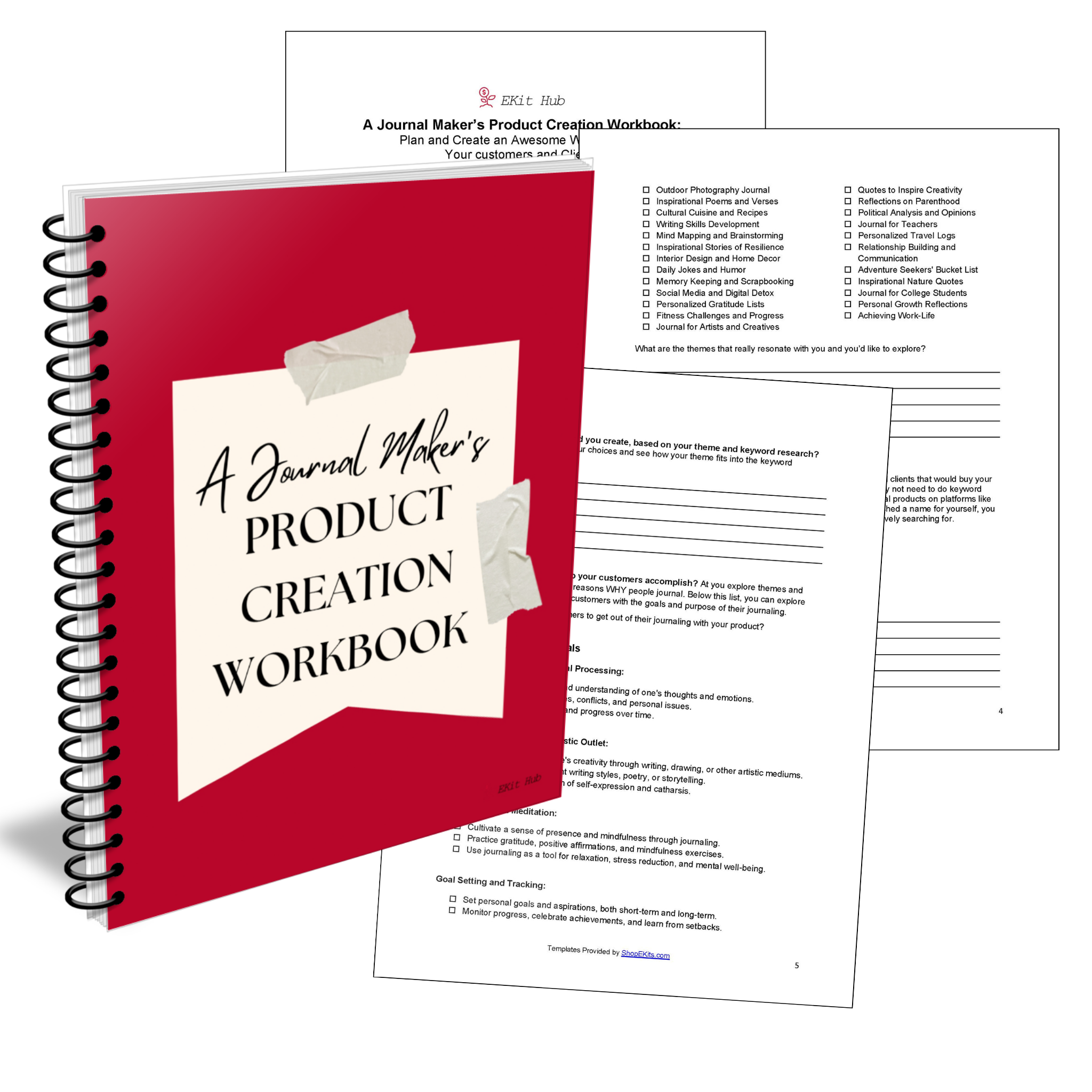How to Create Journal Prompts for a Better Journaling Experience?
If you're a journal maker, this post will give you some practical ideas to create journal prompts to create more customer satisfaction with amazing bullet journal ideas. Because remember, when your customers are happy with their experience and get results, they'll come back for more and they'll send their friends too.
Journals aren’t workbooks, they are meant for more free flow writing…but a guided journal with the right prompts can increase your customer’s satisfaction because they are more likely to get positive results from your journal. And the more satisfied they are and the more they achieve through the journaling process, the more likely they’ll be back.
In Order to Create a More Meaningful Experience...
Understand the Purpose of Your Journal
It's important to know what your journal is about and what it’s ultimate purpose is, so that you can craft prompts and organize your journal to help your customers in the best way possible. By asking the questions below, you'll be able to come up with journaling ideas and prompts that will help your customers brainstorm, and organize their thoughts.
A few questions to ask yourself...
1. What problem does your journal solve? This could be something as simple as keeping a log of wines tasted for a wine journal…or document milestones of pregnancy in a pregnancy journal... or come up with morning journal prompts for a better morning routine, Or it could be a more complicated problem of dealing with an emotional issue in a self-reflection journal.
2. What goal does your journal help your customer achieve? This can go a bit deeper than the problem solving. For example, if it’s a wine journal, maybe the goal is to expand one’s knowledge and ability to discern different wines. In a mental health journal or self-reflection journal, perhaps the goal is to reduce anxiety, be a better parent or any number of things that could be achieved through self-reflection.
3. What specific challenges do your customers face to solve the problem and/or reach the goal? For example, in a wine journal that seeks to expand wine knowledge, the user might need help expanding their knowledge of wines and/or learning to develop their palette to discern between wines. In a self-reflection journal to become a better parent, users might find it difficult to control their emotions or have the time to slow down and be a more conscious parent.
Employ Prompt Creation Techniques

We recommend watching the video at the top of this post as it offers screenshots and visual representations of the examples, but you can continue reading below for prompt techniques.
1. Identify the Main Points Your Customers Should Discover Through their Journaling
For example, if you have a weight loss journal, you might note down the main tools and tips you provide to facilitate weight loss (ex. Drink lots of water, cut sugar, exercise more, etc.). These are NOT prompts and won’t likely be mentioned in the journal, but help you create sort of an outline to guide you in giving your journal buyer experience.
Then to create the actual journal prompts, you might ask things like, “How does it feel when you haven’t reached your goal weight? Are there any self-sabotaging behaviors you engage in when you feel your progress isn’t moving as fast as you’d like.”
Some of the journal ideas you could implement is to add pages that would track their water intake, how they’re feeling throughout the day, etc.
2. Ask Explorative Questions
Some of the easiest ways to create a prompt is simply by asking questions...particularly ones that help your customers get the main points of what you want them to take away from using your journal.
3. Find Thought-Provoking Quotes
Quotes are a great addition to any journal. They can be added to free-writing pages, so the user can consider the quote in their writing, or they can just use the page as they wish. When looking for quotes, look for ones that are in line with the main points or encourage bigger next level thinking.
4. Create Your Own Thought-Provoking Sayings
Sometimes better than quotes are short thought-provoking sayings. You can create your own or you can ask an AI tool like Chat GPT. For example, you can ask ChatGPT: “Create 10 short encouraging sayings about the weight loss journey. Make each saying about 5-7 words long.” Then you can look at the output and select the best ones to match your journal’s message.
5. Consider Adding Statistics
Relevant statistics can inform and motivate people, so you may want to look at government or other statistics gathering website for relevant numbers. Continuing the weight loss example, you could include statistics for obesity or disease…and perhaps follow it up with an encouraging word to motivate the journal user not to be a part of the statistic. Ex. “Over 60 million in the U.S. live with heart disease, but by choosing a healthy lifestyle, it’s easier to avoid that statistic.” (source: CDC)
6. Use Single Words or Images
Sometimes you don’t have to write out a complete prompt. You could choose a word or very short phrase that doesn’t offer any direction in writing, but just allows free thought and writing. For example, in a parenting journal, it might be “parenthood,” “compassion” or “sacrifice”. You could ask ChatGPT to come up with a word list for you and then choose the ones you like best.
An AI prompt might look like: “Can you make a list of words (just one word per line) that are related to parenting? 25 words total.”
7. Encourage List Making
Creating lists is an easy way to get people writing. You can suggest the journal make a list of things they are grateful for in relation to your topic. It could be a list of memories. It could be a list of goals or wishes. There are many possibilities with lists.
8. Allow for Free Brainstorming
What else could you include in your journal that would provide a meaningful experience for your customers?
Once you've brainstormed all your prompts, you should have enough to create a meaningful journal or even a series of journals that provide a results-oriented experience for your customers.
NEXT - Get the Journals Maker's Prompt Workbook

We have a workbook that makes it easy to work through all these tips and create a well-organized meaningful journal for your customers. It's highly recommended to level up your journal creation process.
It will help you through:
- Finding a deeper understanding of your journal, so you can create a more meaningful experience for your customers to encourage more customer satisfaction.
- Gathering up your resources, so you can create a companion journal for your courses, coaching programs, books and more.
- Working from scratch, even if you haven't created courses, coaching programs or books.
- How to craft prompts that will help your customer solve a problem or achieve a goal.
- How to encourage deeper next level thinking, so they can continue to achieve bigger and better results in the future.
- 7 more prompt making techniques and how to carefully use AI tools to craft meaningful prompts to provide a useful experience to your customer.
Click here to get your Journal Maker's Prompt Workbook.
It's a must-have resource for serious journal creators.
Your Might Also Be Interested In...A Journal Maker's Product Creation Workbook

It's perfect for anyone who wants to create journals for sale or as an addition to their courses and coaching programs.
The workbook guides you through:
- Coming up with a theme and topic for your journal (including hundreds of theme and title ideas)
- Keyword research tools to see what is popular.
- Deciding between digital or print journal
- Planning your journal for the best user experience
- Deciding on layouts for your pages
- Designing your journal cover
- Software for creating your journals
Click here to get your journal product creation workbook.
Reaching your journal making and selling goals is much easier with a plan. This workbook will help you make one.
